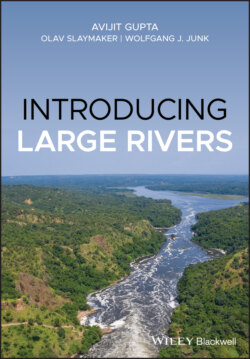Читать книгу Introducing Large Rivers - Avijit Gupta - Страница 32
Box 4.1 Rivers on Alluvial Fans
ОглавлениеSediment yield from fold mountains are characteristically very high (e.g. 104 tkm−2 yr−1) (Douglas and Guyot 2005). The nature of the sediment depends on the regional geology which in a tectonic mountain may include material from active subduction zones, collision belts, volcanic arcs, granitic plutons, rift valleys and uplifted sedimentary rocks (Scatena and Gupta 2013). A significant amount of the sediment is deposited at the foot of the mountains to form alluvial fans. The upper Amazon and its tributaries have built very large alluvial fans at the foot of the Andes. There the material derived from the mountains after deposition is stored for a long time (102–103 years), and progressively weathered into a mature sediment enriched in quartz grains before the grains are removed downstream. The sediment of the Amazon River downstream is derived almost entirely from the Andes and these fans. A series of such large alluvial fans extend along fold mountains. The especially large ones are referred to as megafans as they differ from the common alluvial fans by their large size (103 km2 or greater), low gradient (commonly <0.1°), typical sorted sedimentary texture (boulders at the apex and predominantly silt and mud at toes), and depositional processes (mostly by wandering channels of a single river) (Leier et al. 2005). Megafans are important source of sediment from tectonically active areas in the seasonal tropics (Figure 4.3).
Emerging from the mountains to the plain, The Ganga and its Himalayan tributaries also have built alluvial megafans. The best known of the Himalayan megafans is that of the Kosi River which covers 154 × 147 km in area, and slope 0.89–0.025 m km−1 longitudinally from the Himalayan front to the Ganga River. The climate of the region is affected by the Indian monsoon system. The regional average annual rainfall is between 1300 mm and 1800 mm, 80% of which occurs between June and October. Individual large storms are superimposed on the general rainfall pattern. The Kosi fan consists of large volumes of clastic sediment derived from the Himalaya. On the upper part of the fan, the Kosi River
Figure 4.3 Schematic sketch of the megafan of the Kosi River.
braids over boulders and sand; it has a straighter channel over the sand of the middle fan, and a long meandering reach occurs over fine sand and mud of the lower fan. A tropical large river like the Amazon or Ganga or its major tributaries crosses the fan below the mountains in a channel which is not particularly mobile. The entire length of the fan river, however, may avulse in specific tectonic movements or episodic floods. Its course may also shift randomly during high flow, and the fan becomes a principal source of water and sediment to the trunk river skirting the fan below (Chakraborty et al. 2011; Gole and Chitale 1966; Singh et al. 1993; Wells and Dorr 1987).
